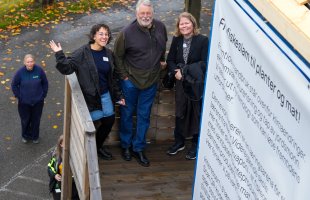Workshop 1 Workshop “How to use aquaponics in the classroom”
On Tuesday, 8 October 2024, NIVA, Natur and Kuben upper secondary schools organized a workshop at Natur upper secondary school to create a meeting point between teachers, students and other actors with and without access to an aquaponic system.
About the workshop
The workshop had 25 participants and created a meeting point between teachers, students and other actors with and without access to an aquaponics system, and established how aquaponics can be used as a learning arena and used in teaching with different student groups. Other aims included engaging in education more related to urban cultivation, sustainability and circularity.
The workshop began with a warm-up using SPLOT (Place, Person, Learning, Observation and Tread) as a method. NIVA gave an introduction to aquaponics which is a combination of two different technologies (hydroponics and aquaculture) that circulate resources such as water and nutrients in a closed loop. Most of the workshop was spent performing groupwork where we used DOGA's method for design-driven innovation to develop activities around how aquaponics can be used in the classroom. Groupwork was digitized and a summary of results was created using the digital app Miro. At the end of the workshop, we took a tour of aquaponics facility at Natur upper secondary school.
There was representation from Fjordakademiet, Kuben, Natur and Rjukan upper secondary schools, as well as NIVA, NMBU, Norges Vel and OsloMet. Ideas and activities generated from Workshop 1 will be used towards Workshop 2 and possibly in addition to modules in a new resource booklet.
Summary of results from groupwork
All the groups emphasized interdisciplinarity and sustainability as central themes. Practical teaching and social learning were consistently important methods. The need for adaptation to different student groups and curricula was also highlighted. Group 1 focused more on organic production and technology. Group 2 emphasized the role of the learning arena and adaptation. Group 3 highlighted social learning and local food production. Group 4 discussed political influence and entrepreneurship. Group 5 focused on implementation challenges in schools.
Similarities between the groups
All groups had a strong emphasis on sustainability, either through practical experiments, economic analysis, or cultural approaches. The use of technology, such as sensors and modeling, was a common trend. Several groups also focused on animal welfare and ethical issues.
Key differences
Research areas varied, with some groups focusing more on practical experiments and teaching, while other groups had a stronger technological and economic approach. One group stood out with its cultural and literary approach to aquaponics. Another group had a unique emphasis on food production and taste testing.
Results of the groupwork
As a result of the groupwork, the groups presented the following activities:
- Student enterprise - Planting Herbs
- Cultivation experiments
- Variable analysis in Aquaponics
- Sustainability and Recycling
- Historical and Technological Comparison



